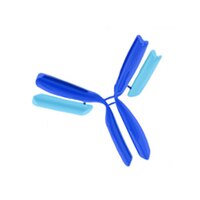Inhibition of platelets and tumor cell adhesion by the disintegrin domain of human ADAM9 to collagen I under dynamic flow conditions.
Marcia R Cominetti,Ana Carolina B M Martin,Juliana U Ribeiro,Ibtissem Djaafri,Françoise Fauvel-Lafève,Michel Crépin,Heloisa S Selistre-de-Araujo
Biochimie
91
2009
Show Abstract
This work aimed to investigate the role of the disintegrin domain of the human ADAM9 (ADAM9D) on the adhesion of breast tumor cells and platelets to collagen I, in a dynamic flow assay to simulate in vivo shear conditions. Recombinant ADAM9D was able to support tumor cell adhesion through binding to the beta1 integrin subunit and also to inhibit the invasion through matrigel in vitro. In a dynamic flow assay ADAM9D inhibited about 75% and 65% of MDA-MB-231 tumor cells and platelet adhesion to collagen I, respectively. In addition, it was demonstrated that alphaVbeta3 integrin is new interacting partner for ADAM9D. In conclusion, these results suggest a role for the disintegrin domain of ADAM9 in the metastatic process. Also, ADAM9D may be a tool for investigating the role of ADAMs in metastasis and cancer progression and for the design of selective inhibitors against the adhesion and extravasation of cancer cells. | 19505527
 |
Characterisation of the influence of anti-gastrin, anti-epidermal growth factor, anti-oestradiol, and anti-luteinising hormone releasing hormone antibodies on the proliferation of 27 cell lines from the gastrointestinal tract.
Darro, F, et al.
Gut, 36: 220-30 (1995)
1995
Show Abstract
Numerous data from published reports prove that the proliferation of gastrointestinal tumour cell lines are under the control of many hormones or growth factors, or both. Most of these publications report the influence on a very small number of cell lines of one or two such factors only. This work deals with the in vitro characterisation of the influence of the anti-gastrin, the anti-epidermal growth factor (EGF), the anti-oestradiol (E2), and the anti-luteinising hormone releasing hormone (LHRH) antibodies on the proliferation of a large series of gastrointestinal cell lines. Cell proliferation was assessed by means of the colorimetric MTT assay on a series of 27 gastrointestinal cell lines obtained from the American Type Culture Collection (ATCC). Of the 27 cell lines, the anti-gastrin, the anti-EGF, the anti-E2, and the anti-LHRH neutralising antibodies considerably influenced the proliferation of 13, 25, 12, and 16. No gastrointestinal cell line was unresponsive to the four antibodies simultaneously. The anti-gastrin and anti-EGF antibody induced effects on the 27 gastrointestinal cell line proliferation were significantly correlated, as was also the case for the anti-E2 and anti-LHRH antibody induced effects. Of the anti-gastrin, the anti-EGF, the anti-E2, and the anti-LHRH antibodies, it was the anti-EGF one that had the greatest influence, both quantitatively and qualitatively, on gastrointestinal cell proliferation. The correlation of the effects of definite anti-hormone antibodies is suggestive of a common mechanism of action for the corresponding hormones and casts some doubt on the efficiency of anti-hormone monotherapy. | 7883221
 |
Simultaneous production of monoclonal antibodies to dehydroepiandrosterone, oestradiol, progesterone and testosterone.
Fantl, V E and Wang, D Y
J. Endocrinol., 100: 367-76 (1984)
1984
Show Abstract
Mice were immunized with a mixture of four steroid antigens: dehydroepiandrosterone (DHA), oestradiol, progesterone and testosterone linked to bovine serum albumin through the 7, 6, 11 alpha and 17 beta positions respectively. The response to immunization varied widely with no one mouse producing an optimal response to all four steroids. In the two fusion experiments performed, antibodies to all four antigens were developed. Data are presented which show that the immune response of the spleen donor is related to the relative numbers and quality of the antibodies produced to each steroid. Despite the structural identity of the progesterone and testosterone haptens, antibodies elicited in response to their respective antigens could readily be distinguished from each other. From the large number of monoclonal antibodies obtained those most useful for radioimmunoassay were three high affinity antibodies to oestradiol and two antibodies raised against DHA but with high affinity for DHA sulphate. | 6230412
 |










